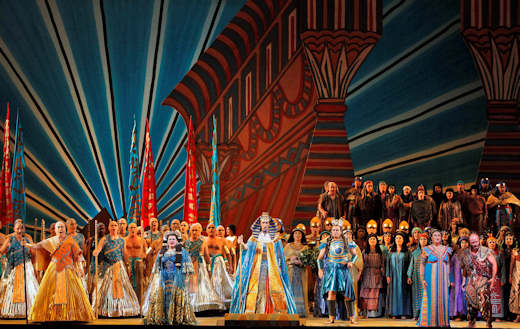Other Links
Editorial Board
- UK Editors
- John Quinn and Roger Jones
Editors for The Americas - Bruce Hodges and Jonathan Spencer Jones
European Editors - Bettina Mara and Jens F Laurson
Consulting Editor - Bill Kenny
Assistant Webmaster -Stan Metzger
Founder - Len Mullenger
Google Site Search
SEEN AND HEARD INTERNATIONAL OPERA REVIEW
Verdi, Aida: Soloists, orchestra and chorus, San Francisco Opera, Nicola Luisotti, conductor. War Memorial Opera House, San Francisco, 24.9.2010 (HS)
Cast:
Aida: Micaela Carosi
Amneris: Dolora Zajick
Radamès: Marcello Giordani
Amonasro: Marco Vratogna
Ramfis: Hao Jiang Tian
The King of Egypt: Christian Van Horn
Priestess: Leah Crocetto
Messenger: David Lomelí
Production:
Conductor: Nicola Luisotti
Director: Jo Davies
Production Designer: Zandra Rhodes
Lighting Designer: Christopher Maravich
Original Choreographer: Jonathan Lunn
Revival Choreographer: Lawrence Pech

Production Picture © Corey Weaver
Any revival of a operatic warhorse should have something to make it special. The San Francisco Opera’s Aida, which opened the 2010-11 season earlier this month and was seen September 24, offers two drawing cards—Zandra Rhodes’ colorful stylized production and mezzo-soprano Dolora Zajick’s definitive Amneris.
Rhodes, the flamboyant British fashion designer, made this production for its Houston Grand Opera debut in 2007. It has since been seen at English National Opera. San Francisco and Norwegian National Opera were co-commissioners. David Gockley, who came to San Francisco as its general director from HGO in 2006, was involved from the beginning.
There is plenty of eye candy in this baby. Bare-chested men in pleated gold lamé skirts. Aqua-colored warrior garments. Radamès in a sort of apron thing with ray-like russet and aqua strips. Lots of gold on the costumes of Amneris and the King. Bald caps painted with ziggurats. Gigantic hair pieces. Stylized Osiris eyes everywhere. Circus tumblers among the dancers. And a full-size puppet elephant manipulated by a crowd, assembled of pieces covered in blue patterned cloth. It lumbers onto the stage bearing the victorious warrior Radamès in the triumphal march and can’t help but make one smile.
But I wonder how much smiling really is appropriate for Aida. After all, this is at heart a very intimate and potentially moving story of love and intrigue. The opera may be famous in the popular world for its spectacle, and certainly that triumphant scene that ends Act II lends itself to all sorts of excess. And yet, the electricity of the triangle involving Amneris, the princess of Egypt, her Ethiopian slave, Aida, and the man they both love (Radamès), singing individually and together, provides most of the opera’s wattage.
And here the biggest jolts came from Zajick’s phenomenal Amneris. Wielding a voice capable of powerful outbursts at both extremes of register and the softest wisp of a floating pianissimo, she made every moment she was on stage crackle. Cajoling Radamès into a liaison he doesn’t really want, warily probing Aida for signs that the love she is hiding is real, and finally crying out to the gods as she hears of Radamès’ final punishment, every moment stabbed the heart and felt totally real.
The only other singer who rose anywhere near Zajick’s heights was baritone Marco Vratogna, as Aida’s father Amonasro. Although Rhodes made him look more like a Mongol warrior than an Ethiopian, his fierce demeanor, ringing voice and boundless energy made him special.
The rest of the cast acquitted itself well enough. In the title role, Italian soprano Micaela Carosi, making her San Francisco opera debut, deployed creamy tone and accurate pitch, but little shading in both of her big arias. “Ritorna vincitor” sounded fine but it had no angst and seemed plodding. “O patria mia” was better, but a relatively narrow dynamic range kept it from being the breathtaking thing it can be. On the other hand, her big, clear, accurate singing rose above the big ensembles thrillingly.
Assaying his first Radamès, tenor Marcello Giordani, who sings mostly lyric roles, opened with a surprisingly blunt “Celeste Aida.” But he gradually seemed to get more comfortable with the role. By the final scene, in which he and Aida die together in a tomb, both he and Carosi were on a roll. Musically, it was absolutely lovely. Basses Hao Jiang Tian as Ramfis, the high priest, and Christian Van Horn as the King of Egypt both rolled out their low lines with sonority and regal stature.
His success with the Italian repertoire was one of the main reasons Luisotti got the job as the music director here, but here he seemed to take a while to get all the musical elements in line. Although the first half, comprising Acts I and II, felt sluggish and never caught fire, the second half started with a slow burn and climaxed with a fiery trial scene. Against the ominous music of the offstage chorus and Tian accusing Radamès of turning traitor and Zajick delivering a whacking fine scena alone on stage, Luisotti whipped up a riveting storm in the orchestra. The fragile legatos of that musically beautiful final scene, constrained by moving flats cut at an angle to form a small triangle center stage, brought the opera to a haunting close.
But in the end, as much as the music brought sighs, the denouement did not bring tears. Perhaps that was because Rhodes’ scenery lacked the gravitas to make us care. Or maybe neither of the two protagonists had created that extra bond with us in the audience that great singing can do. Amneris more successfully got us on her side.
Harvey Steiman
